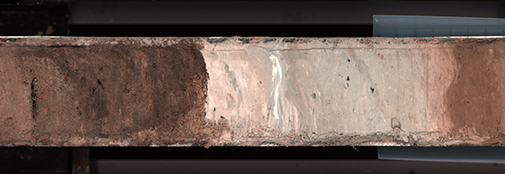Geochemistry and XRF

XRF scanning (X-ray fluorescence spectrometry) identifies and quantifies the elements in materials such as soil samples, minerals, and artefacts. With three distinct XRF instruments in our laboratory, a series of new analytical possibilities is now available to archaeology.
XRF scanning is based on X-ray fluorescence and identifies and measures the concentrations of elements in a sample, without destroying or contaminating it.
XRF scanning can be carried out on both geological and anthropogenic materials such as sediments, bone, teeth, and shell as well as artefacts comprised of minerals, ceramics, bone or metal.
ArchaeoScience has 3 XRF spectrometers suitable for a range of geological, archaeological and forensic applications:
- Our ITRAX µXRF-core-scanner is an automated multi-function core scanning instrument that records optical, radiographic, and elemental variations in sediment cores and monoliths. It is designed to scan at high resolution as fine as 100 μm to reveal fine sedimentary features such as varves or compacted surfaces.
The device focuses an intense X-ray beam through a flat capillary waveguide to irradiate samples and enables both line-scan radiography and µXRF analysis. The instrument is further equipped with a camera for high resolution optical line-scan imaging and a Bartington MS2E magnetic susceptibility detector.
The data from such measurements can be used to characterize sediment layers and estimate organic content and metallic pollutant or clarify depositional sequences. Core scanning data is also useful for correlating multiple cores.
- Our NITON XL3t GOLDD+ XRF analyzer is a portable XRF spectrometer appropriate for field applications. In the laboratory it is used in a stand and perfect for archaeological materials such as beads, bones, pottery, and metal.
XRF data from various archaeological objects may assist in studies of mobility and trade via an analysis of the metal or mineral composition.
- We also have the S2 PUMA XRF spectrometer for elemental analysis of solid, powered or liquid samples. It is an automated devise that be loaded with 20 samples at a time, and is ideal for sediment samples.
XRF analysis is often combined with other types of geological analyses, such as mass spectroscopy (stable isotopes), pollen and plant macrofossils, AMS 14C dating and eDNA analysis.
Contact us to hear more about the many options that XRF scanning offers to modern archaeology.
Contact 
Marie-Louise Siggaard-Andersen
Academic staff
Research: XRF
Phone: +45 23 96 24 76
Email: mlsandersen@sund.ku.dk
